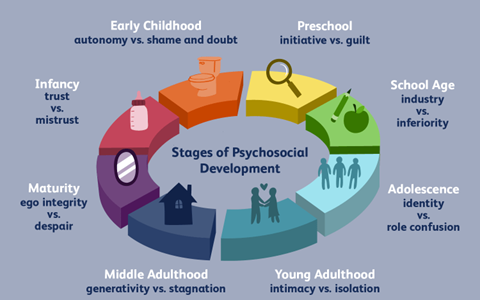According to Erickson’s Psychological theory of development, chronic illness can interfere with which stage of development in a 6-year-old scholar kid?
Trust versus mistrust
Autonomy versus shame and doubt.
Industry versus inferiority
Identity versus role confusion.
The Correct Answer is C
The Industry versus Inferiority stage occurs during the ages of 6 to 12 years old. At this stage, children start to develop a sense of competence and work towards mastering new skills. Success during this stage leads to a sense of pride, while failure leads to feelings of inferiority.
Chronic illness can interfere with a child's ability to develop a sense of competence and mastery, leading to feelings of failure and inferiority. This can have a negative impact on their self-esteem and overall development.

Nursing Test Bank
Naxlex Comprehensive Predictor Exams
Related Questions
Correct Answer is C
Explanation
During the termination phase of the nurse-client relationship, the nurse should focus on making appropriate referrals to ensure that the client continues to receive the care and support they need after the relationship with the nurse has ended.
Option a. Developing realistic solutions is an important task during the working phase of the nurse-client relationship, when the nurse and client work together to identify and implement solutions to the client’s problems.
Option b. Building rapport and trust is an important task during the orientation phase of the nurse-client relationship, when the nurse and client get to know each other and establish a therapeutic relationship.
Option d. Identifying expected outcomes is an important task during the planning phase of the nursing process, when the nurse and client work together to set goals and develop a plan of care.
Correct Answer is C
Explanation
The child is striving for independence.” The behaviors described by the parent are typical for a child who is 26 months old. At this age, children are beginning to develop a sense of autonomy and independence, and they may resist direction and assert their own will. Toilet training can also be a challenging process for both children and parents, and it is not uncommon for children to resist or refuse toilet training at first.
Option a. “The child needs more control. You have been weak” is not a helpful response because it places blame on the parent and does not provide any useful information or guidance.
Option b. “Some undesirable attitudes are developing currently. A child psychologist can help you develop a remedial plan” may be an appropriate response if the child’s behaviors were significantly outside the norm for their age or if they were causing significant distress or disruption. However, based on the information provided by the parent, this does not appear to be the case.
Option d. “There may be developmental problems. Most children are toilet trained by age 2 years and a half” is not a helpful response because it may cause unnecessary worry or concern for the parent. While many children are toilet trained by age 2 and a half, there is a wide range of normal variation in when children achieve this milestone.
Whether you are a student looking to ace your exams or a practicing nurse seeking to enhance your expertise , our nursing education contents will empower you with the confidence and competence to make a difference in the lives of patients and become a respected leader in the healthcare field.
Visit Naxlex, invest in your future and unlock endless possibilities with our unparalleled nursing education contents today
Report Wrong Answer on the Current Question
Do you disagree with the answer? If yes, what is your expected answer? Explain.
Kindly be descriptive with the issue you are facing.
